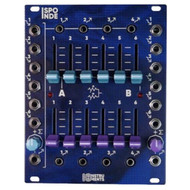Sponde – IO Instruments
by Brandon Ivers
It needs to be said that Berlin-based IO instrument’s modules have some of the nicest feeling knobs and sliders I’ve encountered in this format. I know that isn’t the most important thing in the world, but when you’re performing with mixers and modules that benefit from some hands-on interaction, that kind of thing matters. Hence my enjoyment of IO Instrument’s new 2x6 mixer module, Sponde. Mixers that beg to be played need to feel good, and Sponde passes that test with flying colors. The fact that it sounds incredibly clean and has a ton of matrix-like flexibility is just icing on the cake.
I should be honest and admit that I wasn’t really sure how I would use Sponde in patches when I first gave it a go. The mixer is essentially split into two mix busses, A and B, with six inputs per buss with corresponding sliders for each input. From there, you have a single out for both the A and B busses respectively, and an output for each channel from 1 to 4 (per buss). That’s a lot of inputs and outputs, however there are no CV inputs for controlling the gain of these sliders, so please don’t think of the Sponde as a series of VCAs in a pinch. Sponde is a mixer and nothing more, although because this is Eurorack and Sponde is DC-coupled, “just” being a mixer ends up being a lot more than just adjusting the volume of a couple oscillators and calling it a day.
One of my favorite uses for matrix mixers is to use them as a hub for parallel processing, and the Sponde works very well in this capacity. For example, if you have a couple effect modules, you can plug your source sound(s) into the Sponde’s many inputs, and use the direct channel outputs as your dry mix. The buss outputs can then feed your effect modules, and you have individual control over the amount of “send” you can feed each effect. If you enjoy dub mixing techniques, such as throwing up faders quickly to make delay trails and running inputs back into themselves for feedback patching, the Sponde is awesome for that purpose due the previously mentioned slider quality and routing options available.
Another fun and potentially weird option for using Sponde is to mix CV signals. Folks often forget that a DC-coupled mixer means that CV signals like pitch or envelopes can be mixed together, often with really strange and inspiring results. For example, a thing I really like to do is take two sequences with different timing and pitch and “mix” them, which often provides interesting polyrhythms and pitches that veer towards micro-tonality, especially if you mix two short sequences (3-4 steps in length). You can then use the faders on Sponde to adjust the “amount” of mixing that occurs, which can bend things out of tune and into atonal territory pretty easily. Sponde is obviously not the only mixer in Eurorack that can do this, but the routing flexibility makes it easy to dedicate one buss to CV processing while the other buss can mix audio signals, which is nice.
I’ve noticed that a lot of mixers in Eurorack have opted to shoe-horn themselves into mixers PLUS VCAs, but I think it’s important that Sponde avoids that. By keeping the functionality focused on mixing audio or CVs, you realize how important those tasks can be, not just as a utility, but as a creative tool. Sponde is more than capable of mixing audio with very low distortion or mixing CVs without slew or unintended consequences, and in that sense, there’s a lot packed into this size despite it being rather large at 20 HP. And while I didn’t know how I was going to use Sponde at first, after a couple weeks with this module, I would be pretty sad to go without it. The feel of Sponde, combined with the routing options for feedback patching and CV mixing are just too fun.
20 HP +12v 90mA -12v -82mA
Price: $185


